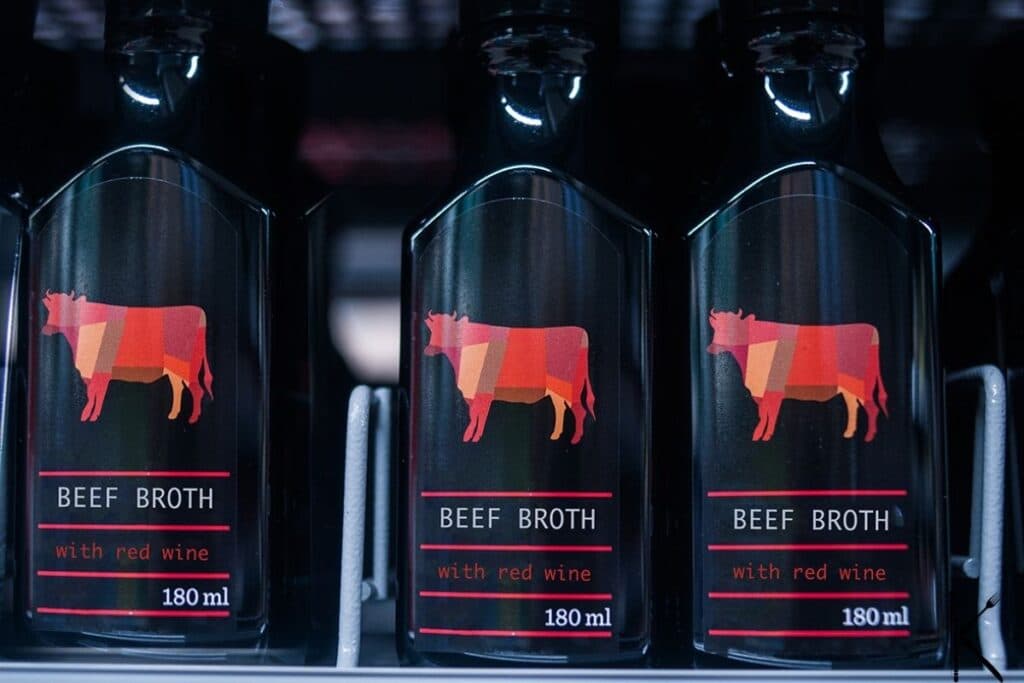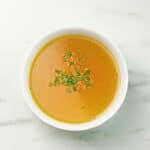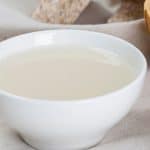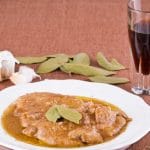Key points:
- The broth is made from meat simmered in water, while stock is made from bones and cartilage simmered for a longer time. Both can be used interchangeably in recipes, but broth has a more immediate flavor intensity.
- Vegetarian substitutes for beef broth include vegetable broth, mushroom broth, and court bouillon.
- Instant substitutes can be made using beef stock, chicken broth, bouillon cubes or granules, soy sauce, wine, or beer.
- Adjust seasoning and intensity as needed to achieve the desired flavor in your recipe.
A good beef broth takes a fair amount of time to make. If you want a quick meal and need broth for your instant noodle bowl, making beef broth from scratch is not going to be an immediate solution. On the other hand, you may have plenty of time but need to find a vegetarian replacement.
There are a few different options you can choose from as a substitute for beef broth. Whether you want to make it from scratch or need a last-minute quick fix, we’ll help you choose the best substitutes for beef broth to suit your recipe.
Beef Broth vs Beef Stock
Before we list the beef broth substitutes, it is worth noting that there is a difference between beef broth and beef stock. Many people use the terms interchangeably, and although there are many similarities, there are also a few factors that distinguish one from the other.
Stocks and broths are both savory liquids packed with flavor. They are made with bones, meat, or vegetables simmered in water. Both liquids are used as a base for making sauces, soups, gravies, and stews. Broth is, however, also often eaten on its own as a clear soup or ladled over noodles, barley, pieces of meat, fish, or vegetables.
The Differences
- Stock is made from meat, chicken, or fish bones that do not have any meat on them. This imparts gelatin, resulting in a thicker consistency and may not necessarily be clear in appearance.
Since stock is made with bones and cartilage without any meat it is cooked for six to eight hours to extract the collagen. It is largely intended to contribute to the mouthfeel of your sauce or soup as opposed to packing a massive punch of meaty flavor. It serves as a rich flavor foundation from which to build your dish.
- Broth refers to meat simmered in water, with or without the bones. It is cooked for a shorter time than stock to prevent the meat from overcooking. If you are making homemade beef broth it is best to remove the meat from the liquid as soon as it is cooked to prevent it from becoming tough. You can always add it back at the end of the cook when your broth has reached the desired flavor and consistency. Alternatively, you can use the cooked meat for an entirely different dish.
- Since broth can be eaten on its own as a clear, light soup it can be seasoned with herbs, spices, or other flavorings. Stock is left unseasoned so that it can be used in a variety of recipes that may have different flavor profiles. This allows you to get a rich flavor base but still season it according to the specific cuisine characteristics.
- Broth sometimes undergoes a clarification process where egg whites are added during cooking. This traps particles that turn the liquid murky as it coagulates. Once strained the broth is a much clearer, lighter liquid.
How To Use Stock vs Broth
Broth and stock can be used interchangeably since they have similar properties. However, if you can choose one over the other, use broth in dishes where you require the most immediate flavor intensity.
For example, if you are making soup or using the liquid as a soup, use broth since it already has plenty of flavors. If you are cooking a beef stew or curry from scratch and are still going to be adding a load of other spices, the stock is the better option as a blank canvas.
Broth is commonly used to cook grains, legumes, risotto, dumplings, and casseroles. It is also used in cream sauces, stuffing, gravies, soups, and sauteed dishes.
Stock is also used when cooking grains and legumes, but makes a good braising liquid and is ideally used when making gravies, tomato sauce, au jus, soups, and stews.
Are Bouillon, Consommé, and Bone Broth the Same as Beef Broth?
To confuse things further, you may be wondering what the difference is between bone broth, bouillon, and beef consommé. Here is a quick rundown.
Bouillon is the French term used for beef broth. Bouillon cubes are dehydrated broth formed into small cubes. They are generally pretty salty but can be a quick solution when you don’t have time to simmer your own beef broth for an hour.
Consommé refers to the broth that has been concentrated and clarified. It is clear, light in color, and rich in flavor.
Bone broth has been all the hype due to its health benefits. It is essentially a stock since it is made by simmering beef bones for up to 24 hours to extract as much collagen as possible. It may contain other seasonings and an acidic component to assist in the breakdown of the bone connective tissues.
Best Beef Broth Substitutes
1. Beef Stock
If the beefy flavor is what you are after, the beef stock will make a good substitute in any recipe. It may be slightly thicker with a less defined flavor, however, this is easy to adjust by adding salt, spices, or herbs and diluting the liquid with a little water if it’s too thick. Substitute beef broth with beef stock in equal amounts.
2. Chicken Broth or Chicken Stock
Chicken broth is made from chicken meat, with or without the bones, vegetables, and herbs. Although it does not have the same beefy intensity, it offers the same consistency and a full-bodied savory flavor. You can buy ready-made chicken broth or make your own. Use it as a beef broth substitute in equal quantities.
3. Vegetable Broth (or Vegetable Stock)
Vegetable broth is a vegetarian and vegan-friendly option that does not contain any meat and therefore lacks the beef flavor. Although it may sound a little boring to some, it is really an incredibly flavorful broth made from onion, carrots, garlic, celery, and even mushrooms.
Making homemade broth is easy and a great way to use up any veggie scraps and fresh herbs. First, saute all the vegetables or vegetable cut-offs in a pot. Then add boiling water and seasoning to simmer for a few hours. Alternatively use a slow cooker.
You can use carrot and celery tops, kale ribs, onion skins, peppers, and garlic amongst a variety of other veggies and herbs. Strain the mixture through a cheesecloth once cooked to attain a semi-clear and rich, flavorful broth.
The great thing is that you can freeze the broth which means none of it has to go to waste. You can also make large batches and portion them for freezing in the required quantities for easy access. Replace 1 cup beef broth with 1 cup of vegetable broth in any recipe.
4. Mushroom Broth
Due to their rich taste and earthiness, mushrooms impart a great deep flavor in recipes. Mushroom broth is a good beef broth substitute for meat lovers or vegetarians. The broth is delicious when used in risotto and sauces but can be a successful and flavorful replacement in any recipe.
Since mushrooms don’t have a very intense flavor on their own, add flavor with a few other components. You can make mushroom broth yourself by simmering assorted mushrooms (chopped), celery, and onion. Optionally add garlic and bay leaves and season with salt and black pepper. This light brown umami liquid can be used as a replacement in equal quantities.
5. Beef Bouillon Cubes
These cubes are an instant solution and simply require being rehydrated in water, almost like soup powder. The cubes are essentially dehydrated broth that has been condensed and pressed into a compact shape. They can be very salty, although low-sodium versions are also available.
Keep in mind that bouillon or stock cubes generally contain some form of additives or stabilizers and are most likely not 100% natural unless the brand specifically states that it is. They also come in other flavors including fish, vegetable, and chicken bouillon cubes.
The reconstituted cubes can be replaced measure for measure in your recipe. Therefore, mix one bouillon cube in one cup of hot water to replace 1 cup of beef broth in any recipe.
6. Bouillon Granules
Bouillon granules are the same as bouillon cubes, except that they are in a granule form rather than a cube form. It is easier to use specifically measured quantities in this case rather than having to use an entire cube or half a cube. You can easily make small adjustments to get the exact flavor intensity you want with granules.
As with the cubes, dissolve the granules as per the manufacturer’s instructions in a cup of water to reconstitute the broth. Then use the liquid as a replacement cup-for-cup in any dish.
7. Soy Sauce
This pantry staple is an instant and easy vegetarian substitute, and you only need one or two tablespoons. Its salty umami flavor and dark color are somewhat reminiscent of beef broth. For the best results add garlic, herbs, or spices to develop a deeper flavor. Since soy sauce contains wheat, you can use liquid aminos instead if you need a wheat-free version.
To make the substitute, mix one tablespoon of regular soy sauce with 1 cup of water. This will replace 1 cup of beef broth. You can adjust the intensity by adding a little more soy sauce or use a low-salt version if you are watching your salt intake. You can use miso paste or steak sauce in a similar way to make a flavorful liquid to substitute beef broth.
8. Court Bouillon
Also known as a short broth, court bouillon is a flavorful savory liquid mainly used for poaching fish, sweetbreads, seafood, or eggs amongst other ingredients. It includes salt and seasonings such as herbs or spices but does not contain any animal gelatin in the form of bones.
Some versions include an acidic component like vinegar or white wine as well as flavor-importing vegetables such as onions and celery.
The difference between court bouillon and other broths is mainly its fast cooking time. This makes it a great substitute to mimic beef broth when you’re in a time crunch. You can use it as a replacement for beef broth in equal quantities.
9. Wine or Beer
Since they lack the meaty taste, wine and beer are not ideal substitutes in soups, but can be great in stews, casseroles, and sauces. To make your substitute, mix dry red wine (or dark beer) in a 1:1 ratio with water. Add spices and seasoning of your choice.
You will have to let it cook for a while to ensure the alcohol cooks out to prevent your dish from having a sharp flavor.
Therefore, using it in long-cooking stews is ideal and can add a lot of body and richness. One cup of diluted wine or beer will equal one cup of beef broth. Therefore, 1 cup of wine mixed with 1 cup of water will equal 2 cups of beef broth substitute.
FAQs
Conclusion
Although there are differences between broth and stock, they can be used interchangeably in most recipes. They take a long time to make at home, but luckily there are some instant solutions for when you are in a pickle.
When you don’t have time to make your own broth you can simply dissolve a bouillon cube, granules, or use soy sauce to add a boost of flavor to the liquid base of your dish.
Remember that most broths and broth substitutes already contain a fair amount of salt which then further reduces cooking. Make sure you taste your dish during cooking before adding more salt and seasonings to keep the perfect balance.
See more:









